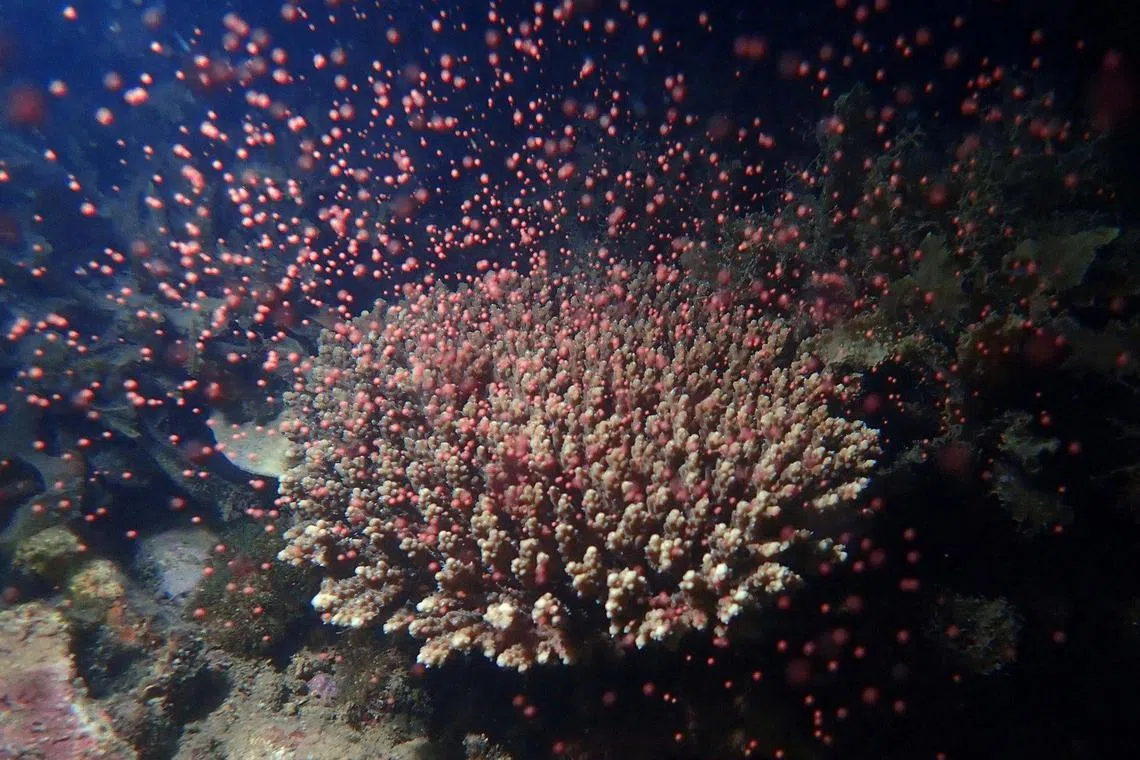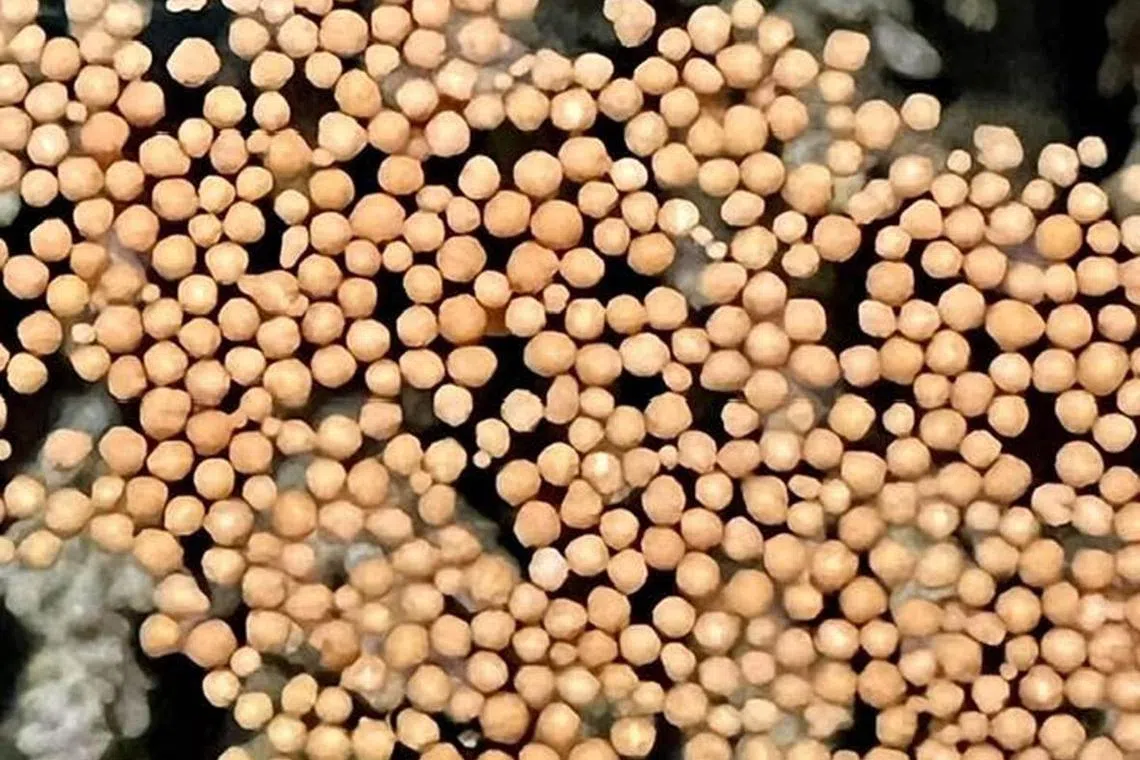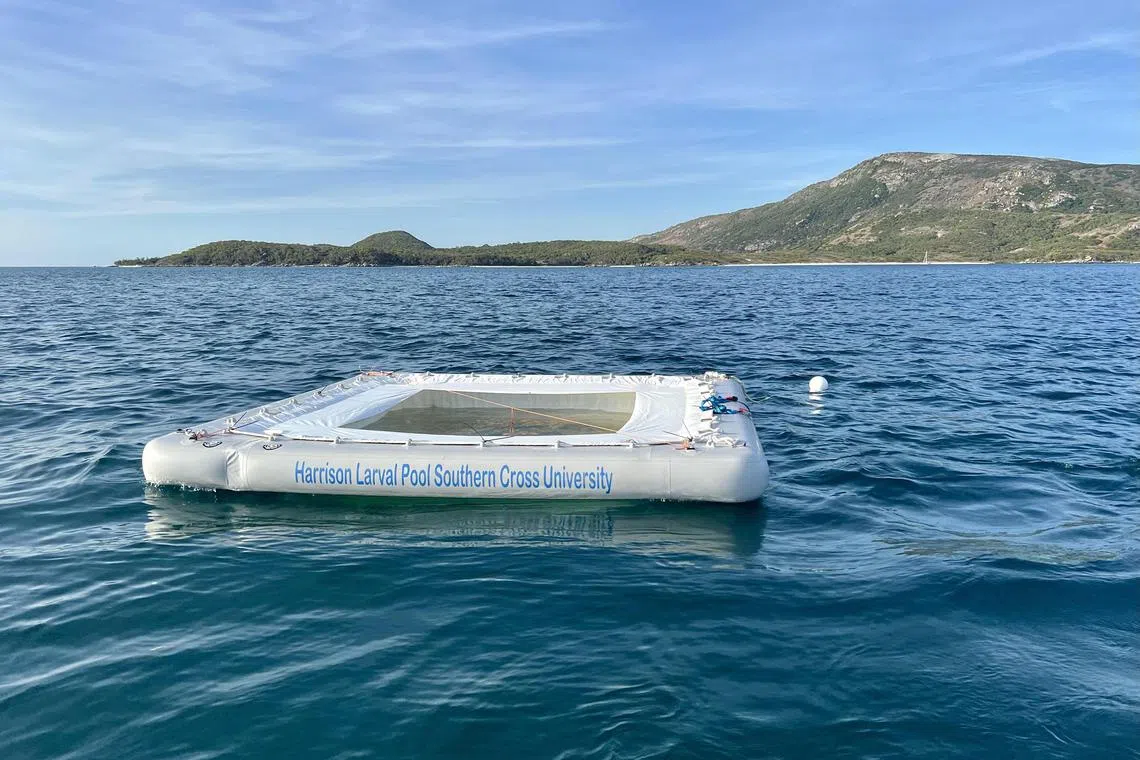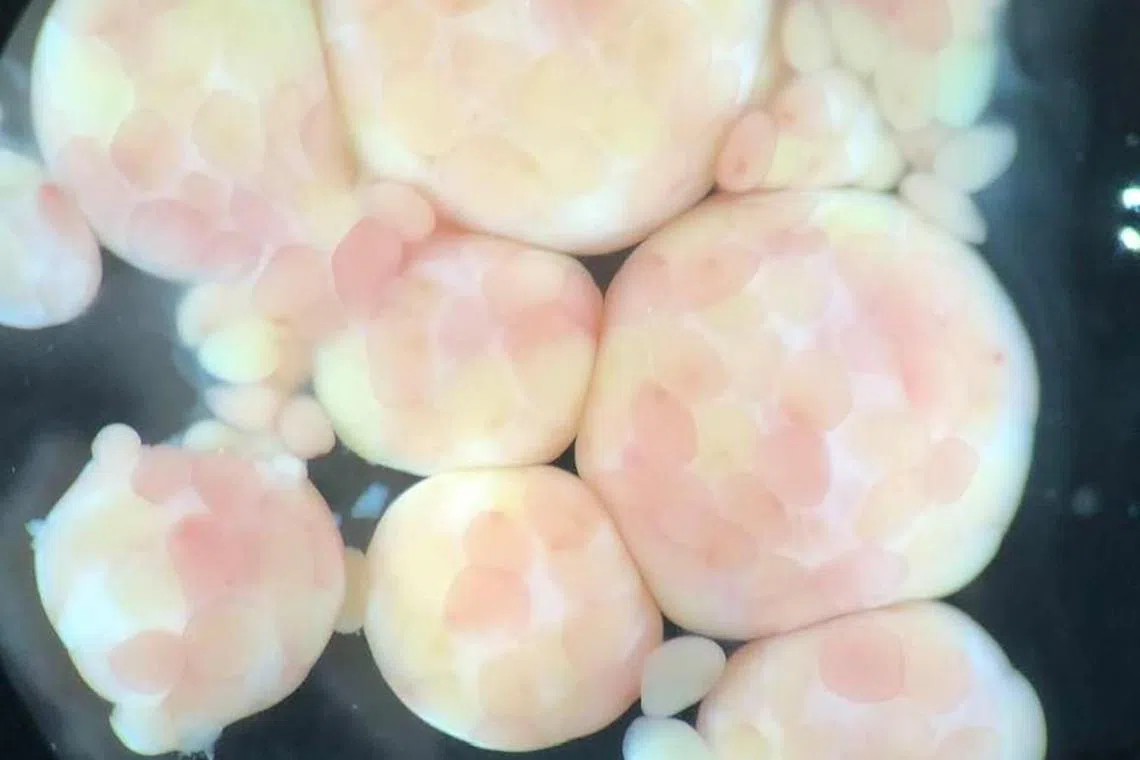Saving the reefs – with coral larval restoration
Sign up now: Get ST's newsletters delivered to your inbox

A colony of the Acropora branching coral, spawning at Magnetic Island, Australia, in 2019.
PHOTO: COURTESY OF PROFESSOR PETER HARRISON, SOUTHERN CROSS UNIVERSITY
Follow topic:
SINGAPORE – In the face of rapidly changing marine environments, one coral reef scientist is experimenting with novel ways of coral propagation that could make these habitats more resilient.
Currently, most coral reef restoration activities around the world involve collecting coral fragments from a “wild” reef and growing them in laboratories before transplanting them onto a degraded site. As the coral fragments are genetically identical to their parents, this method of restoration is also known as asexual fragmentation.
But Professor Peter Harrison from Southern Cross University, Australia, is experimenting with coral larval restoration, which produces genetically unique baby corals instead. This method will ensure corals of greater genetic diversity, which will confer more resilience in the face of marine heatwaves and other threats.
The marine ecologist said that while asexual fragmentation is often adopted by non-governmental organisations to help people understand why corals are important to reef ecosystems, it is inadequate for coral reef restoration and has been overwhelmed by the scale and rate of reef destruction.
“Typically (these corals) have limited genetic diversity and therefore low resilience to things such as bleaching impacts. And (the) most recent modelling is showing that this approach is simply not going to be cost-effective for larger scale, kilometre-types of restoration that we need to be doing urgently now,” he added.
Coral larval restoration and its advantages
Commonly referred to in the media as “ Coral IVF
The research team first locates diverse breeding corals that have survived recent bleaching events, which indicates that they could be more heat-tolerant than those that did not survive.
They then collect the spawn from the corals as they release eggs and sperm in breeding, and transfer it to inflatable pools.

Acropora branching coral eggs and sperm bundles floating at the sea surface after spawning, on the central Great Barrier Reef in Australia, in 2023.
PHOTO: COURTESY OF PETER HARRISON, SOUTHERN CROSS UNIVERSITY
For about five to seven days, the spawn is cultured in a 4m-by-4m inflatable pool, enabling the research team to rear about 10 million larvae.

A floating reef larval culture pool with millions of coral larvae being cultured, temporarily moored on a sandy area near degraded reefs on the northern Great Barrier Reef in 2023.
PHOTO: COURTESY OF PROFESSOR PETER HARRISON, SOUTHERN CROSS UNIVERSITY
When the larvae are ready to settle, they will be released in one of two ways. One is to release the larvae through a pipe directly to a reef. The other is to place pieces of dead coral or limestone tiles in the larval pool so that the larvae can settle on them directly.
Researchers then monitor the larvae to determine if the process was successful and how to refine their method in the following year or in a different reef environment.
Prof Harrison, who is also the founding director of the Marine Ecology Research Centre at Southern Cross University, said that modelling processes indicate that coral larval restoration is much more scalable for large-scale restoration and is more cost-effective than traditional approaches such as asexual fragmentation.
This method also promotes increased genetic diversity, which enables higher resilience of the restored corals, he added.
His team has had more than 20 successful reef trials in the Philippines and on the Great Barrier Reef and colonies that were established to restore coral populations in degraded reef areas are now dominating these reefs again, as compared with control sites.

Coral egg and sperm bundles of the genus Platygyra, also known as “brain corals”, spawned at Heron Island, Australia, in 2020.
PHOTO: COURTESY OF PETER HARRISON, SOUTHERN CROSS UNIVERSITY
“We had the world’s fastest growth record (from spawn) to sexual reproduction after two years. So within a couple of years, our restored colonies are spawning,” Prof Harrison said.
He added that 18 million larvae released into a highly degraded reef system in the Philippines in 2020 which had been blast-fished have now developed into a diverse range of corals. Including brain corals and branch corals, they now cover an area of about 0.6ha, similar to the size of a football field.
How ‘Coral IVF’ came about
In 1981, Prof Harrison was part of a team of marine biology PhD researchers that observed a mass spawning event, where trillions of eggs and sperm were released by multiple coral species on Australia’s Great Barrier Reef, while diving at night by torchlight.

A large coral spawn slick floating at the sea surface after a mass coral spawning event on the northern Great Barrier Reef in 2023.
PHOTO: COURTESY OF PETER HARRISON, SOUTHERN CROSS UNIVERSITY
That memory came back to him years later after a traumatic event.
He lost about half of the hundreds of corals that he had tagged for research to a major bleaching event in the area, and was devastated. “It was such a shock that I started to think, ‘How can we try to use what we know about sexual reproduction in a way in which we might be able to repair some of those damaged reef systems?’ So the idea for coral larval restoration has origins during this discovery way back in the early 1980s,” Prof Harrison said.
Rising ocean temperatures since February 2023 have led to the most extensive global coral bleaching event
When ocean temperatures rise, corals expel the algae that live in their tissues, causing them to turn white, or bleach.
Global coral bleaching events also occurred in 1998, 2010 and 2016, affecting Singapore’s coral reefs as well.

Corals in Pulau Hantu showed signs of bleaching earlier in October.
ST PHOTO: AUDREY TAN
Those years and 2024 coincided with El Nino, a climate phenomenon that raises sea surface temperatures in the eastern Pacific and contributes to increased global temperatures.
“We’re losing coral reefs at a rate that was almost unimaginable when I first started my work on reefs 40 years ago. We now have a global coral crisis where natural reef resilience has been overwhelmed by chronic human impacts and severe natural disturbances,” Prof Harrison said.
Large-scale restoration plans ahead
Prof Harrison spoke about his research at the Blue Water EduFest 2024, an ocean conservation event organised by hotel and yacht club One15 Marina, from Nov 7 to 9 at Sentosa Cove.

Professor Peter Harrison and his team hope to build a South-east Asia community of larval restoration networks to share their research on coral larval restoration with people in as many regions as possible.
ST PHOTO: ARIEL YU
At a panel discussion, Prof Harrison and other scientists from Singapore talked about the dire state of global coral reefs and the importance of community involvement in marine conservation and restoration efforts.
He and his team of about 10, including PhD students, postdoctoral researchers and full-time staff members, intend to scale up their restoration projects by working with local communities in the Philippines and the Great Barrier Reef, and have plans to expand these projects to Indonesia and Vietnam.
“We want to build a South-east Asia community of larval restoration networks. So our vision is that hopefully, within five to 10 years, we will be able to get resources from other governments or philanthropic organisations to enable us to build capacity, buy more larval pools and get the information out to people in as many regions as possible,” Prof Harrison said.

